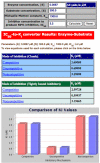The zinc-dependent protease activity of the botulinum neurotoxins
- PMID: 22069621
- PMCID: PMC3153231
- DOI: 10.3390/toxins2050978
The zinc-dependent protease activity of the botulinum neurotoxins
Abstract
The botulinum neurotoxins (BoNT, serotypes A-G) are some of the most toxic proteins known and are the causative agents of botulism. Following exposure, the neurotoxin binds and enters peripheral cholinergic nerve endings and specifically and selectively cleaves one or more SNARE proteins to produce flaccid paralysis. This review centers on the kinetics of the Zn-dependent proteolytic activities of these neurotoxins, and briefly describes inhibitors, activators and factors underlying persistence of toxin action. Some of the structural, enzymatic and inhibitor data that are discussed here are available at the botulinum neurotoxin resource, BotDB (http://botdb.abcc.ncifcrf.gov).
Keywords: Km; catalysis; energy; kcat; superactivation.
Figures




References
-
- Rabasseda X., Blasi J., Marsal J., Dunant Y., Casanova A., Bizzini B. Tetanus and botulinum toxins block the release of acetylcholine from slices of rat striatum and from the isolated electric organ of Torpedo at different concentrations. Toxicon. 1988;26:329–336. - PubMed
Publication types
MeSH terms
Substances
Grants and funding
LinkOut - more resources
Full Text Sources
Other Literature Sources
Medical

